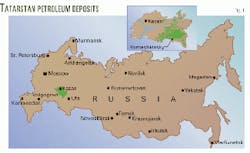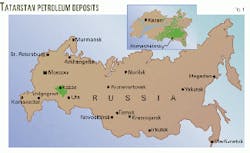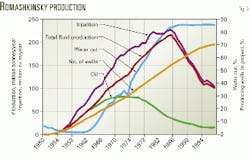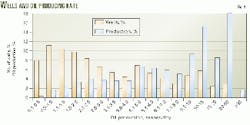Redevelopment aims to stabilize, hike oil production from Romashkinsky
ROMASHKINSKY REDEVELOPMENT-1
Redevelopment of AO Tatneft's operated multireservoir Romashkinsky oil field, in Tatarstan, Russia, aims not only to stabilize oil production but possibly increase it.
The plan is in place, although low oil prices during the last few years have delayed some of the required fundamental and applied research required for initiating part of the program.
This first of a two-part series on redevelopment of the field describes the field and some of the problems that must be overcome. The second part will discuss results to date.
The redevelopment study included estimates of the economics for redeveloping the entire field as well as economics on a well-by-well basis.
For solving this complicated problem, the study required integrating many complex variables for both the main and auxiliary production and included analyzing the efficiency of production technology options, evaluating the market for the produced oil, and determining the ecological consequences of the redevelopment.
Field description
Romashkinsky field's (Fig.1) main producing horizons are in Devonian and Bobric formations. These account for 97% of estimated original oil in place and are at a late depletion stage. As of Jan. 1, 1999, 91.3% and 55.9%, respectively, of proven initial recoverable reserves had been produced from these reservoirs.
About 22 horizons in the Devonian and Carboniferous contain oil, with 18 horizons producing oil at commercial rates. Oil recovery from the formations other than the main producing formations is at an initial stage. Previously these formations did not generate any interest because original estimates indicated that they contained only 3% of original initial oil in place.
But in the next few years, these formations (specifically the Vereiskian-Serpukhovian, Tournaisian, Famennian, and Givetian horizons) may contribute a significant amount of production. Current studies indicate that these horizons contain about 10% of the initial oil in place, instead of the 3% previously estimated.
Their share of remaining recoverable oil may be almost one-third of that for the entire field because the main zones are essentially depleted, producing with water cuts of 96.5% from the Devonian and 73.5% from the Bobric formations.
The Bobric horizons started to be developed in 1943. This was followed by production from the Devonian in 1952. The Devonian is in its fourth production scheme. The first was developed from 1953-56. A second scheme was developed during 1965-68, and a third scheme followed that in 1975-77.
The field's maximum oil production from Devonian deposits was 81.5 million tonnes/year (1.6 million bo/d) in 1970. The field sustained this rate for 6 years. In 1998, oil production was 11.2 million tonnes (220,000 bo/d), or 13.7% of the maximum value.
Oil production from Bobric horizon in 1980 reached a maximum of 7.2 million tonnes/year (142,000 bo/d). Currently it produces 2.8 million tonnes/year (55,000 bo/d).
Oil recovery from other formations does not exceed 0.8 million tonnes/year (16,000 bo/d).
Targeted formations
The Devonian sand deposits (Pashiyskian and Kynovskian horizons) had most (more than 88.3%) of the estimated initial oil reserves in the field. The Lower Carboniferous sands contained about 8.7% of the initial oil reserves.
The carbonates having the main commercial significance are in the Upper Tournaisian substage of the Lower Carboniferous and Vereiskian-Bashkirian horizons of Middle Carboniferous (Fig. 2).
In addition there are more than 400 other reservoirs in the field, but most of these horizons have less commercial interest because of their smaller size and limited extent.
The Pashiyskian horizon (D1) and Kynovskian horizon (D1) are multilayer oil pools with an average oil-water contact at 1,490 m.
In the central part of the field, all D1 horizons are oil-bearing, but at the outer periphery of the field, the number of oil-bearing formations tends to diminish. Also net pay thickness is less at the periphery.
The D0 horizon is oil-bearing only in the southwestern, western, and northern parts of the field.
The Pashiyskian horizon (D1) is a multilayer oil pool, which is characterized by frequent alternation of sandy-aleurolite and clays. The main parameters of D1 formations are as follows:
- 28.2-46.3 m gross thickness.
- 3.7-16.6 m effective oil-bearing formation thickness.
- 18.8-20.7% porosity.
- 0.339-0.666 md permeability.
- 69.1-83.4% oil saturation.
- 25.9-52.0 net % sand factor.
- 1.2-5.3 multilayer factor.
The Tournaisian deposits extend over the entire field and are carbonates. About 170 separate pools have been found. These pools are massive and confined to third- order structures.
Smaller oil pools have been combined, and at present only 21 oil pools are under consideration for development. Most pools are small, 0.5-2 km long, but a few are larger, 6-13 km long by 3-7 km wide. Thickness may reach 35-45 m.
In Lower Carboniferous sands, commercial oil accumulations are confined to the Radaevskian, Bobric, and Lower Tulskian horizons. About 100 of these oil pools have been identified, each having a different size and different net oil thickness. At present 37 oil pools are being considered for development. A wide range of sizes characterizes these, for example, 2-35 km long by 1-21 km wide. Thickness ranges from 3 to 47 m.
In the Middle Carboniferous, the largest oil deposits found are in the southwestern part of the field at an elevated section of the Minnibaevksy terrace in the Kuakbashsko-Shugurovsky structure, which is in an elongated trend.
Along the cap rock of the Vereiskian horizon, the structure sizes are 1.5-20 km with a height of up to 50-60 m. Oil is confined to the Middle Carboniferous, Serpukhovian and Bashkirian stages, and Vereiskian horizon in the Moskovian stage. Their heterogeneity and lack of continuity characterize these formations.
Among the limited oil-bearing pools, the most significant are sands of the Starooskolskian horizon (Givetian stage), Middle Devonian, Dankovo-Lebyadinskian horizon (Middle Famennian substage), Zavolzhskian horizon (Upper Famennian substage), Upper Devonian, Upino-Malevskian, and Aleksinskian horizons (Lower Carboniferous).
Table 1 lists the distribution of initial and remaining recoverable reserves for the different horizons that are classified as separate producing formations. The table indicates that the share of remaining reserves in undeveloped horizons is increasing.
Producing schemes
When the Romashkinsky oil field was first being developed, peripheral waterflooding efficiency had already been proven in the Tuimazinsky (Bashkortostan, Russia) and Bavlinsky (Tatarstan, Russia) fields.
Preliminary estimates, however, showed a low efficiency for this technology in the D1 horizon of Romashkinsky oil field because most of the thickness and best productive formations are in the central part of the arch. On the flanks, the thickness of the oil-bearing formations gradually decrease and reservoir properties deteriorate.
Because of this, the Romashkinsky oil field was developed with water injection wells in rows, dividing the field into 21 areas. Each area was considered a separate production unit.1
Waterflooding improved technical and economic indices for the operation and contributed to starting commercial oil recovery in less time and with minimum costs. It also allowed for wider well spacing, thus saving resources and accelerating development.
The geologic structure of the field was not completely delineated when the initial development planning started. At the time, there was a rush to produce oil at high rates. Complete delineation would take another 15 years.
For this reason, planning was carried out without regard for all geologic features. Moreover, this type of waterflooding was new to the world and not many case studies had been published. As a result, the waterflood had a low conformance, and it primarily produced from only the higher productivity formations.
The initial producing scheme was gradually altered by including state-of-the-art stimulation methods and by taking into account geological features in specific areas.
Some of the scheme that was not altered included:
- Pressure maintenance with rows of water injection wells, divided into individual production units.
- Producing first from the higher productive intervals.
- Completion of alternate injection wells to boost oil recovery from infill wells.
The second scheme included drilling new rows of wells with the aim to start producing from the central, temporarily suspended areas. The new rows reduced the distance between the producing and injection rows.
During this phase, injection pressure was increased so that the formation pressure in the vicinity of injection wells also increased and artificial lift caused the bottomhole pressure in producing wells to be lowered to the bubblepoint pressure, 8.5-9.0 MPa (1,230-1,305 psi).
In some areas isolated from injection zones, the scheme recommended spot waterflooding. Pattern waterflooding was used in the peripheral areas without much areal extent in the primary formations.
The third scheme intensified development by:
- Increasing randomly the density of well patterns in the more productive areas to obtain a production-to-injection well ratio of 1:3.
- Installing an independent waterflooding system in the central areas for low productivity intervals that were not effectively developed when commingled with the higher productivity intervals.
- Developing the oil contained in the oil-water zone and in low-productivity intervals.
- Optimizing pressure differentials.
- Including geologic and physical factors in the development program.
- Including timely shut in of water-encroached formations
- Applying state-of-the-art enhanced oil recovery (EOR) methods, both chemical and hydrodynamic.
In the present fourth scheme, field redevelopment includes:
- Further optimizing well patterns and waterflooding to account for vertical and areal geological peculiarities.
- Treating injected water based on reservoir petrophysical properties and formation mineral composition.
- Improving primary and secondary well completion methods.
- Using bottomhole treatments and hydraulic fracturing.
- Introducing chemical, seismic, sonic, wave, and microbial EOR methods.
- Drilling slim holes and sidetracks to lower development costs.
- Analyzing in detail to determine the location and amount of remaining recoverable oil with 3D geologic and mathematical models.
- Carrying out additional exploration and development of oil found in less- extensive oil intervals.
Current status
The field currently has 24,853 wells. This represents 70.3% of the planned wells in the proposed redevelopment. Of these wells, about 78.2% penetrate the Devonian sands and 71.8% the Carboniferous.
The redevelopment calls for all other productive intervals to be developed by either recompletions or by a limited number of wells drilled in pilot areas.
Currently active are 10,936 producing wells and 4,898 injection wells. About half of the shut-in wells are uneconomical to produce because of low oil producing rates and high water cuts. These wells would need to be repaired and the depleted zones isolated.
As of Jan. 1 1999, 86.0% of the initial proved recoverable reserves had been produced. This represents about 42.1% of the oil in place.
The field currently produces with a 1.6 water-oil ratio.
In 1971, the field reached its maximum oil production rate (Fig. 3) before starting a gradual decline until the late 1970s when the oil-decline rate steeply increased. Total fluid production reached a peak in 1985, at which time water cut had increased to 83.7%.
After 1985, both oil and water production decreased, although water cut remained nearly constant at 85.3-85.7%. Typical oil production rates per well fell to about 4.4 tonnes/day (32 b/d) with total fluid produced/well being about 32 tonnes/day (230 b/d) (Fig. 4).
Under the existing taxation system, more than 65% of the operating wells producing from the Devonian are uneconomic. These wells produce about 25% of the oil from the field and if the new Tatarstan law on mineral resources had not provided tax relief for oil recovery from highly watered out and marginal wells, these well would have been shut in.
Redevelopment problems
The main technological problem for redeveloping the field is caused by the commingling of heterogeneous multilayer horizons, D1D0. These zones were developed nonuniformly. And the best reservoirs are depleted, with only the poorer reservoirs containing oil.
Producing this oil requires new technology for drilling, water treatment, enhanced oil recovery, among others.
The nonuniform development also has created new areas with bottom water drive.
Initially water-oil zones were formed only in the peripheral areas. Later, waterflooding of the best formations created water-oil zones over the entire area. This led to increased water cuts from both horizontal displacement and water coning.
The redevelopment plan aims to restrict water production.
Sustained oil production rates and decreased production decline rates are possible only if recoverable oil is present. To assess remaining reservoirs, the new development plan includes exploratory drilling in some of the more limited reservoirs. Another important task is to create new technologies and techniques on recovering more of the residual oil from waterflooded areas.
In Romashkinsky oil field, various drilling techniques have been used to penetrate the D1D0 horizons. The wide spacing between the initial rows of injectors and producers was eventually infill drilled.
Also at first, the wells adjacent to the injection rows were changed to water injectors when the water cut reached 50%. Later, the change occurred on a well-to-well basis and only if a well reached a 90% water cut.
Cyclic waterflooding has also made it difficult to determine how much oil remains and where it is located.
The ages of wells and deterioration of their physical conditions create many problems. The physical condition has to be verified and appropriate repairs made.
Another problem is to treat the water properly for flooding. Its quality needs to be more stringent because injection pressure has to be increased to displace oil from low-productivity reservoirs.
The field also requires flexible systems for maintaining formation pressure on a wide scale. Lifting the oil from wells is another problem with the main difficulty being to limit water production from wells producing oil at low rates.
Environmental problems are growing with the aging wells and oil field equipment as a result of increasing production of highly saline formation water. Leaks in the production facilities have caused salinization of arable land and potable water sources. Also the field has problems with polluting the atmosphere.
Reservoir problems that occur when water is injected into oil-saturated reservoirs also need to be dealt with in redevelopment of the field. These problems include:
- Growth of anaerobic microbes in the flooded part of formation.
- Temperature variances throughout the field.
- Increased reservoir pressure in the vicinity of injection wells.
- Drawdown of pressure near producing wells.
- Emergence of weak artificial gravitational and electric fields because of the salinity differences in the water flowing through the porous media.
- Deterioration of the formation permeability because of poorly treated injected water that plugs pores.
- Possible swelling of clay fractions, wax deposition, etc.
These problems are enhanced because the D1D0 horizons are heterogeneous and multilayer. For instance, the negative effects of injecting cold water may worsen the properties of adjacent formations.
The D1D0 horizons now produce with a high water cut and low oil production. The other horizons are characterized by low oil production, high viscosity oil, with low recovery factors.
At present such horizons are developed, primarily, by well recompletion. But new wells have to be drilled for producing these horizons, although the current tax system may make such drilling uneconomical.
Reference
- Galeev, R.G., Muslimov, R.Kh., Diyashev, R.N., and Blinov, A.F., "40 Years Experience of Romashkinsky Oil Field Development in Tatarstan: Improvements of Water Flooding," 8th European Symposium on Improved Oil Recovery, May 15-17, 1995, Vienna.
The Authors
Rasim N. Diyashev is deputy-director in the field of geology and development of oil and gas reservoirs of TatnipIneft institute, Tatneft JSC, Bugulma, Russia. He specializes in the design and development of oil fields, well tests, enhanced oil recovery, and thermal recovery of heavy crude and bitumen. Diyashev holds degrees as a technician-geophysicist from the Exploration Geology Technical School, Ufa, reservoir engineering from the Petroleum Institute, Ufa, and candidate and doctor of technical sciences from the Moscow Gubkin Institute of Oil & Gas Industry and from the All-Union Petroleum Research Institute, Moscow. He is a member of SPE, AAPG, EAGE, and the Russian Academy of Natural Sciences (RANS).
Alexei F. Blinov is head of the laboratory for development studies on the Romashkinsky oil field in the TatNIPIneft R&D Institute of AO Tatneft, Bugulma, Russia. He has been involved in scientific investigations in the field of hydrodynamic methods of well research, analysis, and design of oil fields development.
Rais S. Khisamov is chief geologist, deputy director general at AO Tatneft, Almetyevsk, Russia. His interests include geology, improvement of the system of oil and oil-and-gas fields development, oil recovery hydraulics and mechanics, and enhanced oil recovery. Khisamov graduated from the Tatar Technical Faculty of Moscow Gubkin Oil & Gas Institute and has doctor of sciences in geology and mineralogy from the All-Union Petroleum Research Institute, Moscow.








